Interaction of Wu’s Slip Features in Bioconvection of Eyring Powell Nanoparticles with Activation Energy
Abstract
1. Introduction
2. Mathematical Modeling
3. Numerical Solution
4. Validation of Solution
5. Analysis of Results
6. Concluding Remarks
- ❖
- A devaluate distribution of velocity has been observed for higher values of combine parameter, first order slip parameter and second order slip parameter.
- ❖
- The distribution of velocity attains maximum values with mixed convection parameter.
- ❖
- The nanoparticles temperature rises with thermophoresis parameter, Biot number and radiation parameter.
- ❖
- A decreasing variation in nanoparticles concentration has been figured out for mixed convection parameter and Brownian motion constant.
- ❖
- Both Peclet number and the bio-convection Lewis number retarded the motile microorganism distribution.
- ❖
- The observations presented here can be simulated to enhance the performances of various thermo-extrusion systems.
Author Contributions
Funding
Conflicts of Interest
References
- Choi, S.U.S. Enhancing Thermal Conductivity of Fluids with Nanoparticles; No. ANL/MSD/CP-84938; CONF-951135-29; Argonne National Lab.: IL, San Francisco, CA, USA, 1995; Volume 66, pp. 99–105. [Google Scholar]
- Madhu, M.; Kishan, N. Finite Element Analysis of heat and mass transfer by MHD mixed convection stagnation-point flow of a non-Newtonian power-law nanofluid towards a stretching surface with radiation. J. Egypt. Math. Soc. 2016, 24, 458–470. [Google Scholar] [CrossRef]
- Sheikholeslami, M.; Haq, R.; Shafee, A.; Li, Z.; Elaraki, Y.G.; Tlili, I. Heat transfer simulation of heat storage unit with nanoparticles and fins through a heat exchanger. Int. J. Heat Mass Transf. 2019, 135, 470–478. [Google Scholar] [CrossRef]
- Gupta, S.; Kumar, D.; Singh, J. MHD mixed convective stagnation point flow and heat transfer of an incompressible nanofluid over an inclined stretching sheet with chemical reaction and radiation. Int. J. Heat Mass Transf. 2018, 118, 378–387. [Google Scholar] [CrossRef]
- Hayat, T.; Qayyum, S.; Alsaedi, A.; Ahmad, B. Magnetohydrodynamic (MHD) nonlinear convective flow of Walters-B nanofluid over a nonlinear stretching sheet with variable thickness. Int. J. Heat Mass Transf. 2017, 110, 506–514. [Google Scholar] [CrossRef]
- Turkyilmazoglu, M. Free and circular jets cooled by single phase nanofluids. Eur. J. Mech. B-Fluid 2019, 76, 1–6. [Google Scholar] [CrossRef]
- Tlili, I.; Khan, W.A.; Ramadan, K. MHD Flow of Nanofluid Flow Across Horizontal Circular Cylinder: Steady Forced Convection. J. Nanofluids 2019, 8, 179–186. [Google Scholar] [CrossRef]
- Ahmed, J.; Khan, M.; Ahmad, L. Stagnation point flow of Maxwell nanofluid over a permeable rotating disk with heat source/sink. J. Mol. Liq. 2019, 287, 110853. [Google Scholar] [CrossRef]
- Khan, M.I.; Alsaedi, A.; Hayat, T.; Khan, N.B. Modeling and computational analysis of hybrid class nanomaterials subject to entropy generation. Comput. Meth. Prog. Biol. 2019, 179, 104973. [Google Scholar] [CrossRef]
- Ahmed, A.; Nadeem, S. Effects of magnetohydrodynamics and hybrid nanoparticles on a micropolar fluid with 6-types of stenosis. Results Phys. 2017, 7, 4130–4139. [Google Scholar] [CrossRef]
- Khan, M.; Azam, M.; Alshomrani, A.S. Unsteady slip flow of Carreaunanofluid over a wedge with nonlinear radiation and new mass flux condition. Results Phys. 2017, 7, 2261–2270. [Google Scholar] [CrossRef]
- Powell, R.E.; Eyring, H. Mechanisms for the relaxation theory of viscosity. Nature 1944, 154, 427–428. [Google Scholar] [CrossRef]
- Javed, T.; Ali, N.; Abbas, Z.; Sajid, M. Flow of an Eyring-Powell Non-Newtonian Fluid over a Stretching Sheet. Chem. Eng. Comm. 2013, 200, 327–336. [Google Scholar] [CrossRef]
- Khan, N.A.; Sultan, F. On the double diffusive convection flow of Eyring-Powell fluid due to cone through a porous medium with Soret and Dufour effects. AIP Adv. 2015, 5, 057140. [Google Scholar] [CrossRef]
- Khan, S.U.; Ali, N.; Hayat, T. Analytical and Numerical Study of Diffusion of Chemically Reactive Species in Eyring-Powell Fluid over an Oscillatory Stretching Surface. Bulg. Chem. Commun. 2017, 49, 320–330. [Google Scholar]
- Mallick, B.; Misra, J.C. Peristaltic flow of Eyring-Powell nanofluid under the action of an electromagnetic field. Eng. Sci. Technol. Int. J. 2019, 22, 266–281. [Google Scholar] [CrossRef]
- Akbar, N.S.; Ebaid, A.; Khan, Z.H. Numerical analysis of magnetic field effects on Eyring-Powell fluid flow towards a stretching sheet. J. Magn. Magn. Mater. 2015, 382, 355–358. [Google Scholar] [CrossRef]
- Malik, M.Y.; Khan, I.; Hussain, A.; Salahuddin, T. Mixed convection flow of MHD Eyring-Powell nanofluid over a stretching sheet: A numerical study. AIP Adv. 2015, 5, 117118. [Google Scholar] [CrossRef]
- Khan, S.U.; Ali, N.; Abbas, Z. Influence of Heat Generation/Absorption with Convective Heat and Mass Conditions in Unsteady Flow of Eyring Powell Nanofluid over Porous Oscillatory Stretching Surface. J. Nanofluids 2016, 5, 351–362. [Google Scholar] [CrossRef]
- Wang, S.; Ardekani, A.M. Unsteady swimming of small organisms. J. Fluid Mech. 2012, 702, 286–297. [Google Scholar] [CrossRef]
- Elfring, G.J.; Goyal, G. The effect of gait on swimming in viscoelastic fluids. J. Non-Newton Fluid 2016, 234, 8–14. [Google Scholar] [CrossRef][Green Version]
- Kuznetsov, A.V. The onset of nanofluidbioconvection in a suspension containing both nanoparticles and gyrotactic microorganisms. Int. Commun. Heat Mass Transf. 2010, 37, 1421–1425. [Google Scholar] [CrossRef]
- Kuznetsov, A.V. Nanofluidbioconvection in water-based suspensions containing nanoparticles and oxytactic microorganisms: Oscillatory instability. Nanoscale Res. Lett. 2011, 6, 100. [Google Scholar] [CrossRef] [PubMed]
- Siddiqa, S.; Begum, N.; Saleem, S.; Hossain, M.A.; Gorla, R.S.R. Numerical solutions of nanofluid bio-convection due to gyrotactic microorganisms along a vertical wavy cone. Int. J. Heat Mass Transf. 2016, 101, 608–613. [Google Scholar] [CrossRef]
- Khan, A.; Farooq, M.; Gull, N.; Hayat, T. Magnetohyrodynamic (MHD) stratified bio-convective flow of nanofluid due to gyrotactic microorganisms. Adv. Powder Technol. 2017, 28, 288–298. [Google Scholar]
- Khan, W.A.; Uddin, M.J.; Ismail, A.I.M. Free convection of non-Newtonian nanofluids in porous media with gyrotactic microorganisms. Trans. Porous Media 2013, 97, 241–252. [Google Scholar] [CrossRef]
- Xun, S.; Zhao, J.; Zheng, L.; Zhang, X. Bio convection in rotating system immersed in nanofluid with temperature dependent viscosity and thermal conductivity. Int. J. Heat Mass Transf. 2017, 111, 1001–1006. [Google Scholar] [CrossRef]
- Waqas, H.; Khan, S.U.; Hassan, M.; Bhatti, M.M.; Imran, M. Analysis on the bio convection flow of modified second-grade nanofluid containing gyrotactic microorganisms and nanoparticles. J. Mol. Liq. 2019, 291, 111231. [Google Scholar] [CrossRef]
- Waqas, H.; Khan, S.U.; Shehzad, S.A.; Imran, M. Radiative flow of Maxwell nanofluid containing gyrotactic microorganisms and energy activation with convective Nield conditions. Heat Transf.-Asian Res. 2019, 48, 1663–1687. [Google Scholar] [CrossRef]
- Dero, S.; Uddin Md, J.; Rohni, A.M.R. Stefan Blowing and Slip Effects on Unsteady Nanofluid Transport Past a Shrinking Sheet: Multiple Solutions. Heat Transf. Asian Res. 2019. [Google Scholar] [CrossRef]
- Tlili, I. Effects MHD and Heat Generation on Mixed Convection Flow of Jeffrey Fluid in Microgravity Environment over an Inclined Stretching Sheet. Symmetry 2019, 11, 438. [Google Scholar] [CrossRef]
- Goodarzi, M.; Tlili, I.; Tian, Z.; Safaei, M. Efficiency assessment of using graphene nanoplatelets-silver/water nanofluids in microchannel heat sinks with different cross-sections for electronics cooling. Int. J. Numer. Methods Heat Fluid Flow 2019. [CrossRef]
- Afridi, M.I.; Tlili, I.; Goodarzi, M.; Osman, M.; Khan, N.A. Irreversibility Analysis of Hybrid Nanofluid Flow over a Thin Needle with Effects of Energy Dissipation. Symmetry 2019, 11, 663. [Google Scholar] [CrossRef]
- Tlili, I. Tawfeeq Abdullah Alkanhal, Nanotechnology for water purification: Electrospun nanofibrous membrane in water and wastewater treatment. J. Water Reuse Desalin. 2019, 24. [Google Scholar] [CrossRef]
- Tlili, Iskander. Thermodynamic Study on Optimal Solar Stirling Engine Cycle Taking Into Account the Irreversibilities Effects. Energy Procedia. 2012, 584–591. [Google Scholar] [CrossRef]
- Tlili, I.; Khan, W.A.; Ramadan, K. Entropy Generation Due to MHD Stagnation Point Flow of a Nanofluid on a Stretching Surface in the Presence of Radiation. J. Nanofluids 2018, 7, 879–890. [Google Scholar] [CrossRef]
- Wu, L. A slip model for rarefied gas flows at arbitrary Knudsen number. Appl. Phys. Lett. 2008, 93, 253103. [Google Scholar] [CrossRef]
- Nandeppanavar, M.M.; Vajravelu, K.; Abel, M.S.; Siddalingappa, M. Second order slip flow and heat transfer over a stretching sheet with non-linear Navier boundary condition. Int. J. Therm. Sci. 2012, 58, 143–150. [Google Scholar] [CrossRef]
- Rosca, A.V.; Pop, I. Flow and heat transfer over a vertical permeable stretching/shrinking sheet with a second order slip. Int. J. Heat Mass Transf. 2013, 60, 355–364. [Google Scholar] [CrossRef]
- Khan, S.U.; Waqas, H.; Shehzad, S.A.; Imran, M. Theoretical analysis for tangent hyperbolic nanoparticles with combined electrical MHD, activation energy and Wu’s slip features: A mathematical model. Phys. Scr. 2019. [Google Scholar] [CrossRef]
- Ibrahim, W. Magnetohydrodynamics (MHD) flow of a tangent hyperbolic fluid with nanoparticles past a stretching sheet with second order slip and convective boundary condition. Results Phys. 2017, 7, 3723–3731. [Google Scholar] [CrossRef]
- Ali, F.M.; Nazar, R.; Arifin, N.M.; Pop, I. MHD boundary layer flow and heat transfer over a stretching sheet with induced magnetic field. Heat Mass Transf. 2011, 47, 155–162. [Google Scholar] [CrossRef]
- Tlili, I.; Khan, W.A.; Khan, I. Multiple slips effects on MHD SA-Al2O3 and SA-Cu non-Newtonian nanofluids flow over a stretching cylinder in porous medium with radiation and chemical reaction. Results Phys. 2018, 8, 213–222. [Google Scholar] [CrossRef]
- Tlili, I.; Hamadneh, N.N.; Khan, W.A. Thermodynamic Analysis of MHD Heat and Mass Transfer of Nanofluids Past a Static Wedge with Navier Slip and Convective Boundary Conditions. Arab. J. Sci. Eng. 2018, 1–13. [Google Scholar] [CrossRef]
- Tlili, I.; Hamadneh, N.N.; Khan, W.A.; Atawneh, S. Thermodynamic analysis of MHD Couette—Poiseuille flow of water—Based nanofluids in a rotating channel with radiation and Hall effects. J. Therm. Anal. Calorim. 2018, 132, 1899–1912. [Google Scholar] [CrossRef]
- Khan, W.A.; Rashad, A.M.; Abdou, M.M.M.; Tlili, I. Natural bioconvection flow of a nanofluid containing gyrotactic microorganisms about a truncated cone. Eur. J. Mech.-B/Fluids 2019, 75, 133–142. [Google Scholar] [CrossRef]
- Khalid, A.; Khan, I.; Khan, A.; Shafie, S.; Tlili, I. Case study of MHD blood flow in a porous medium with CNTS and thermal analysis. Case Stud. Therm. Eng. 2018, 12, 374–380. [Google Scholar] [CrossRef]
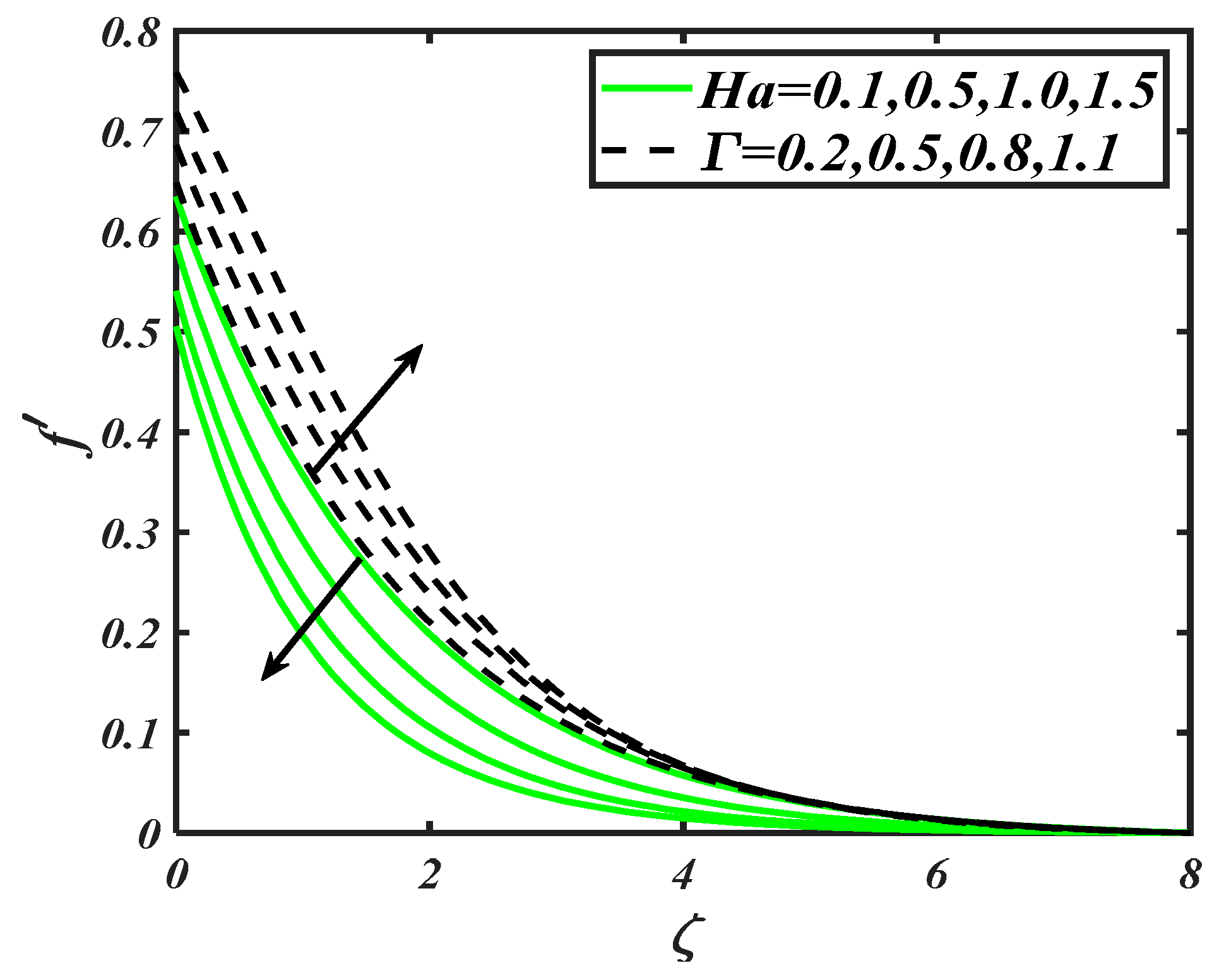
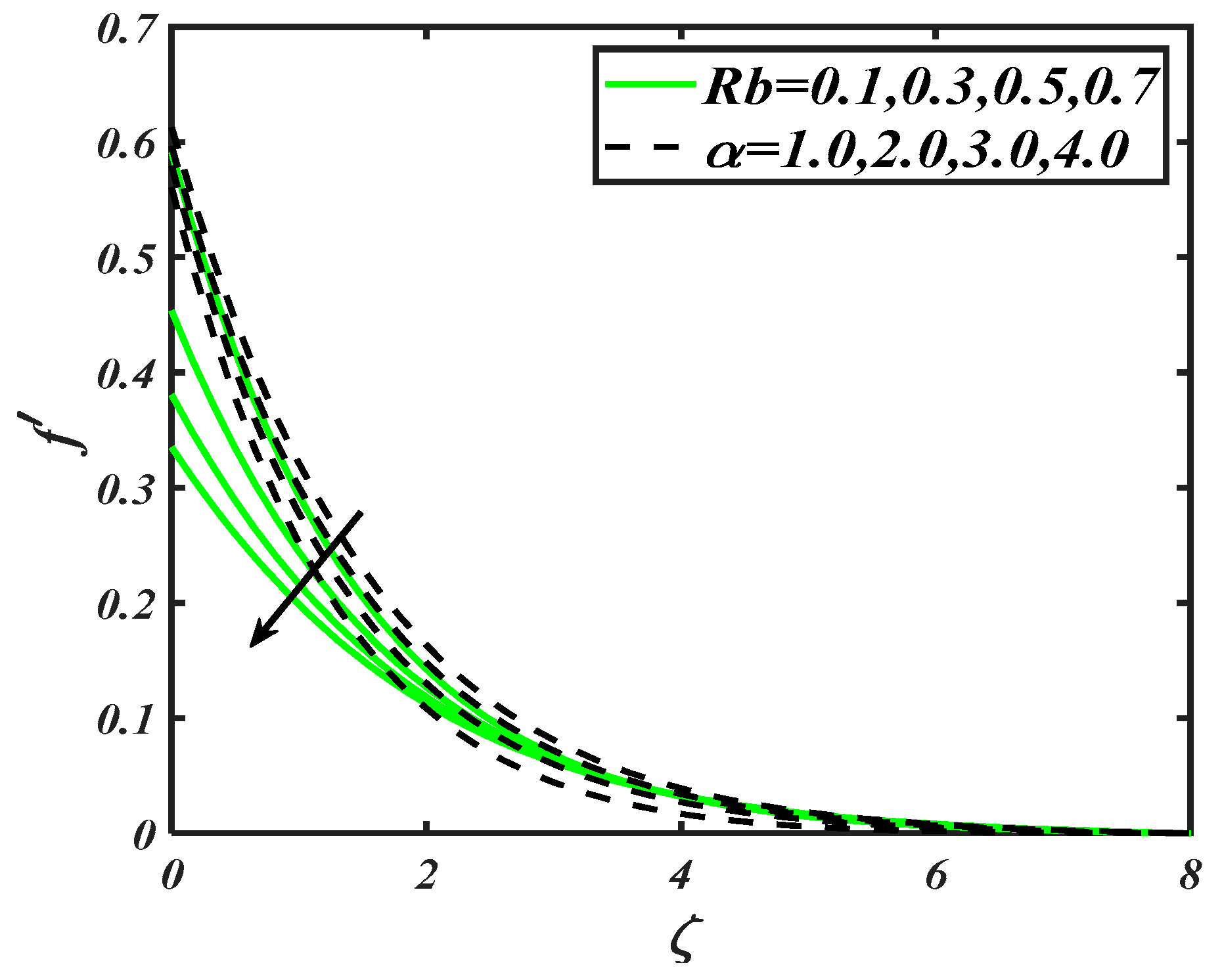
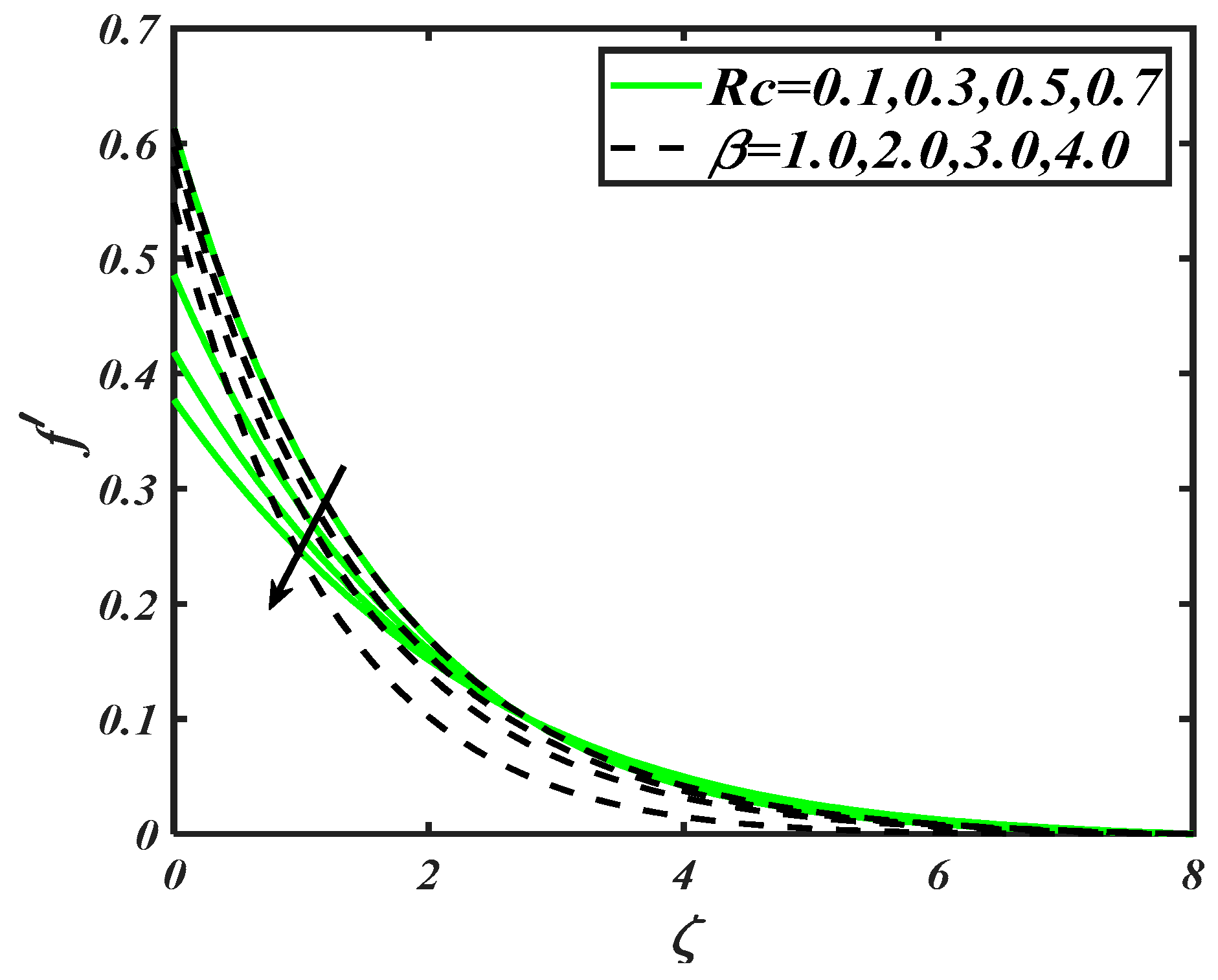
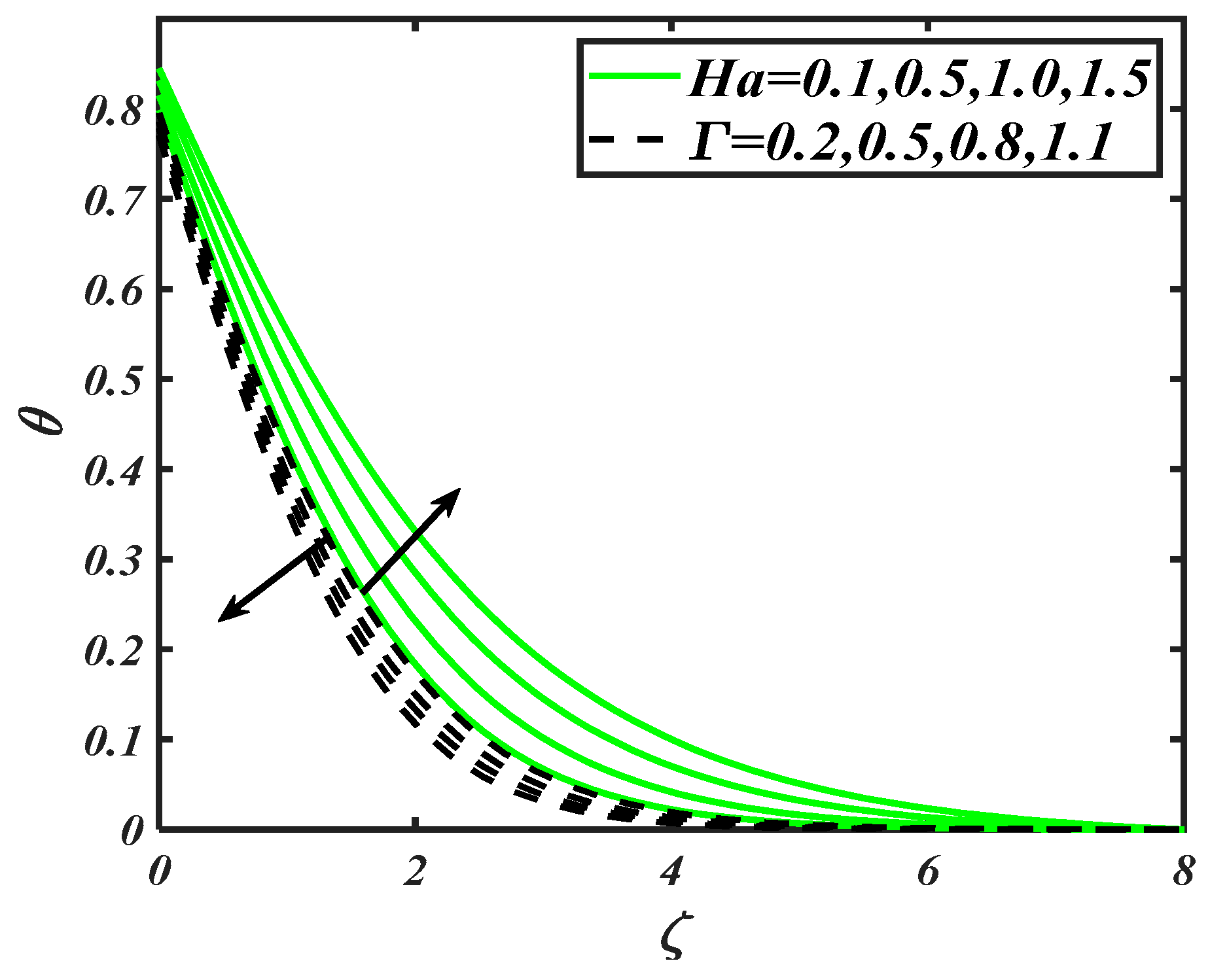
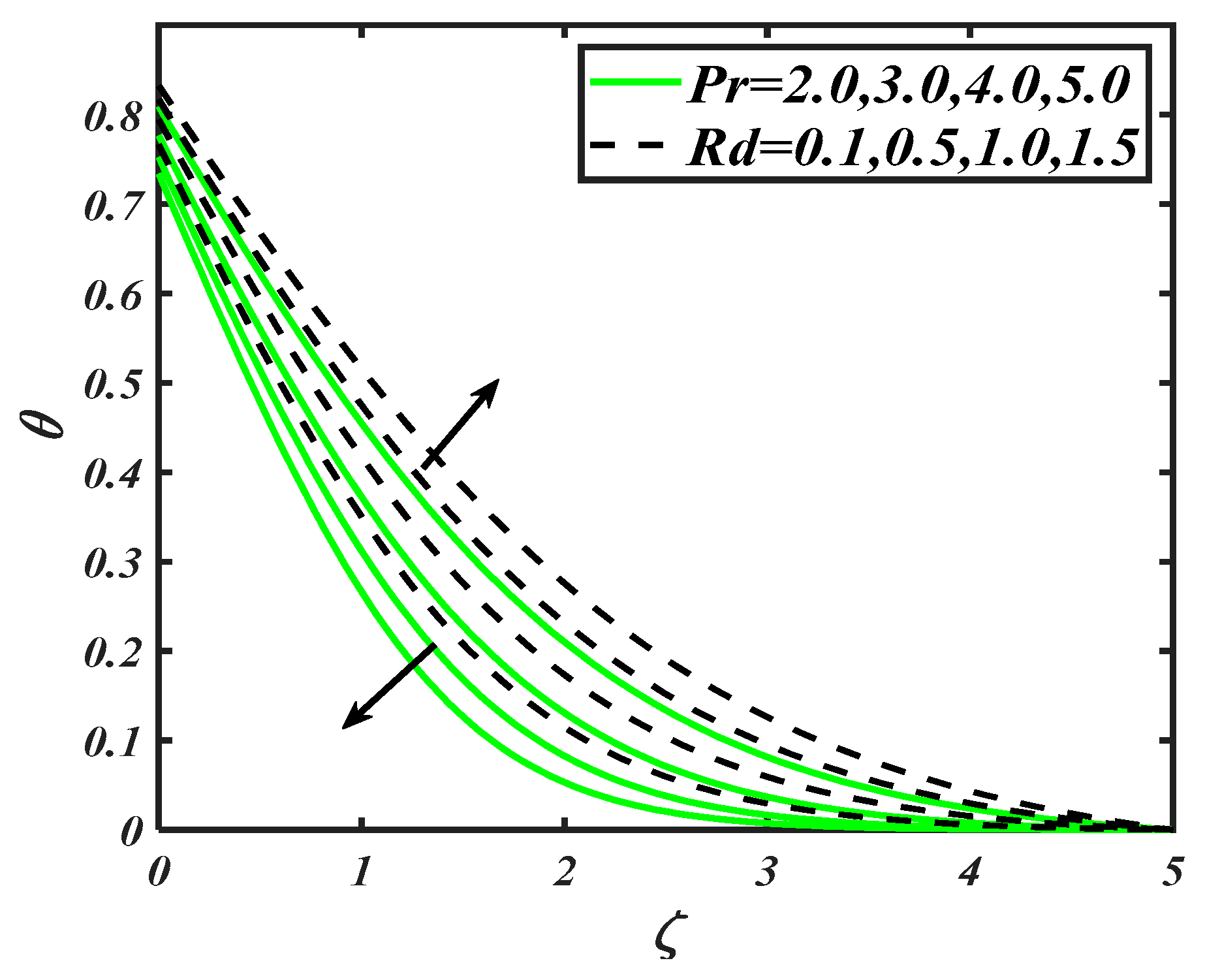
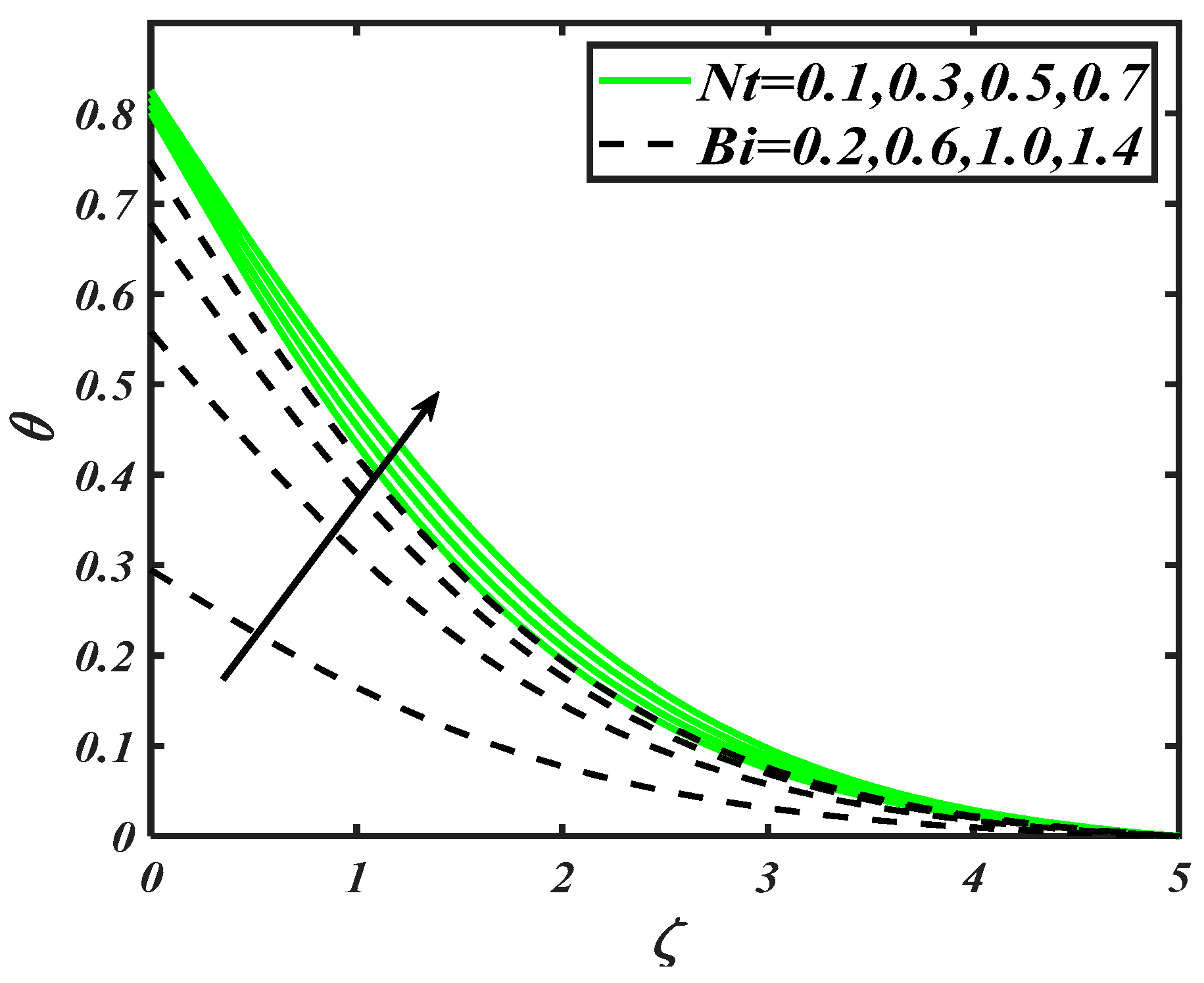
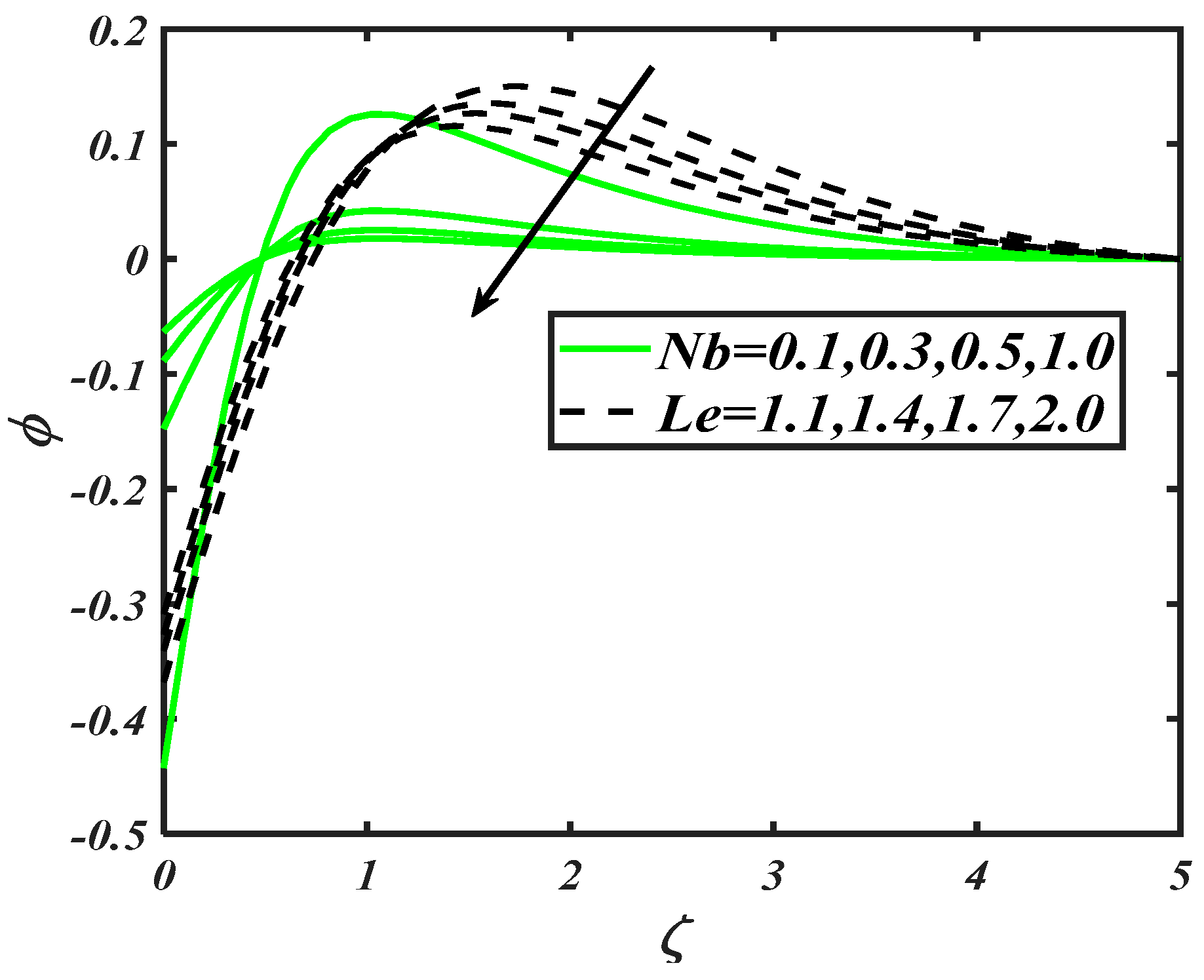
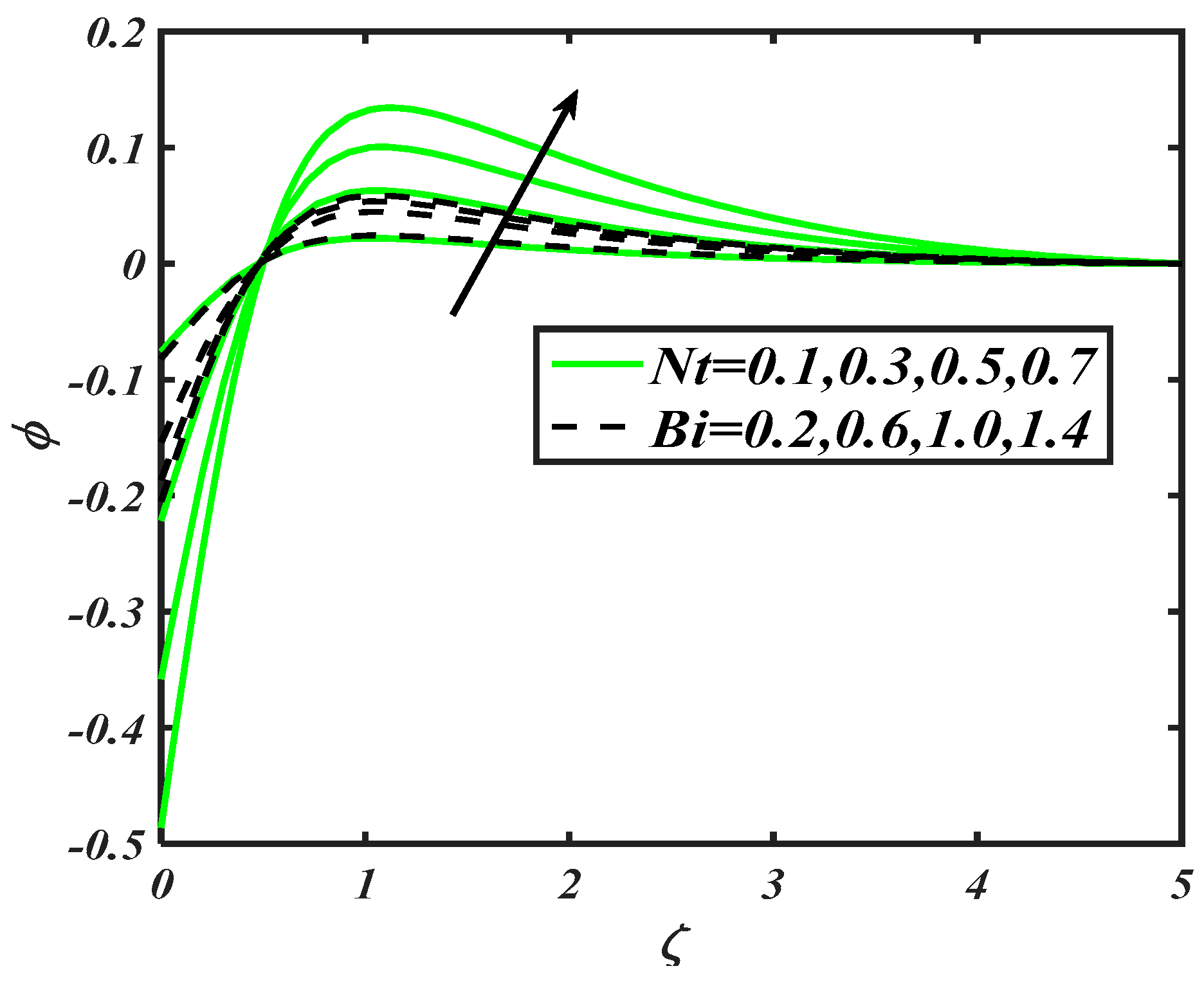
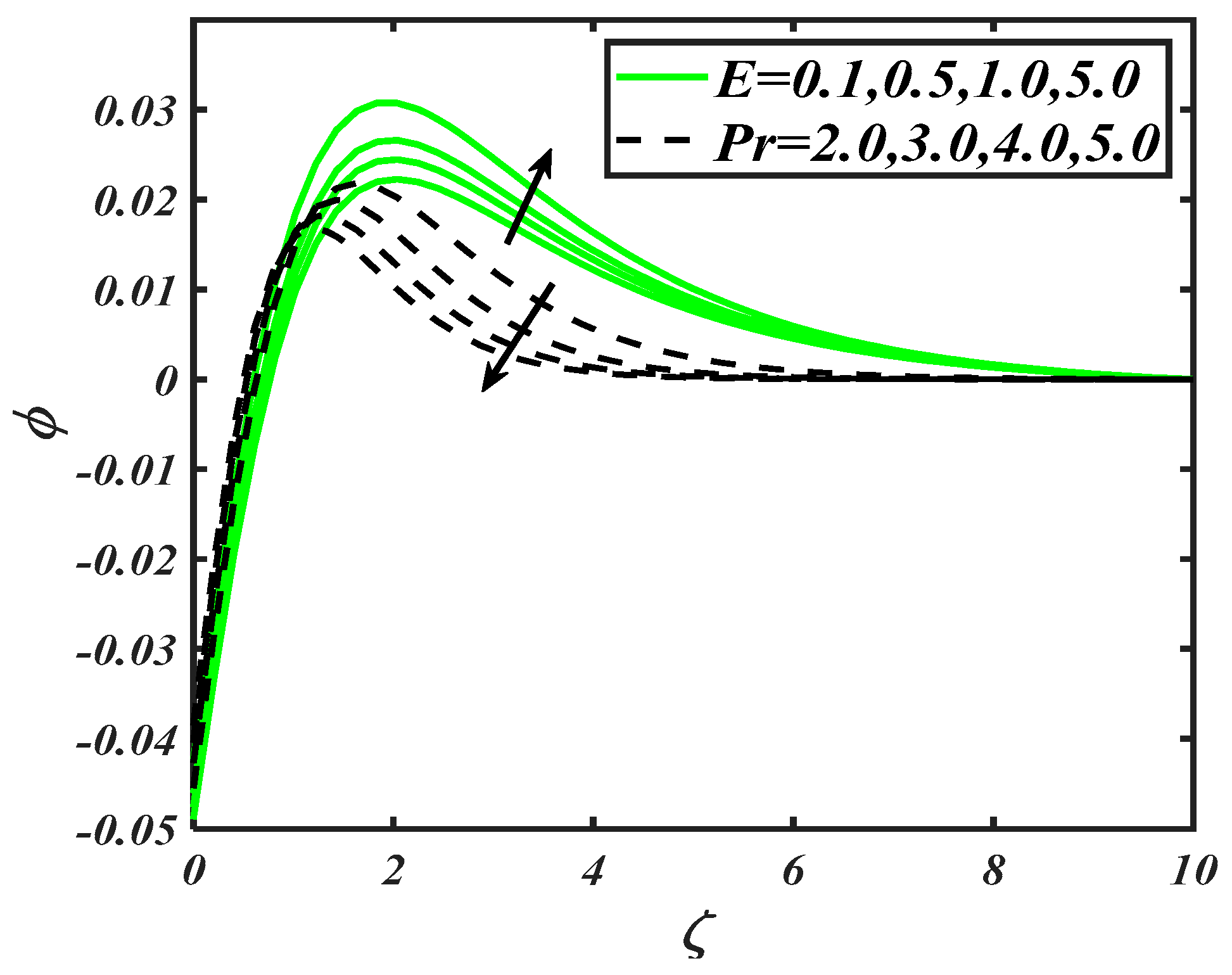
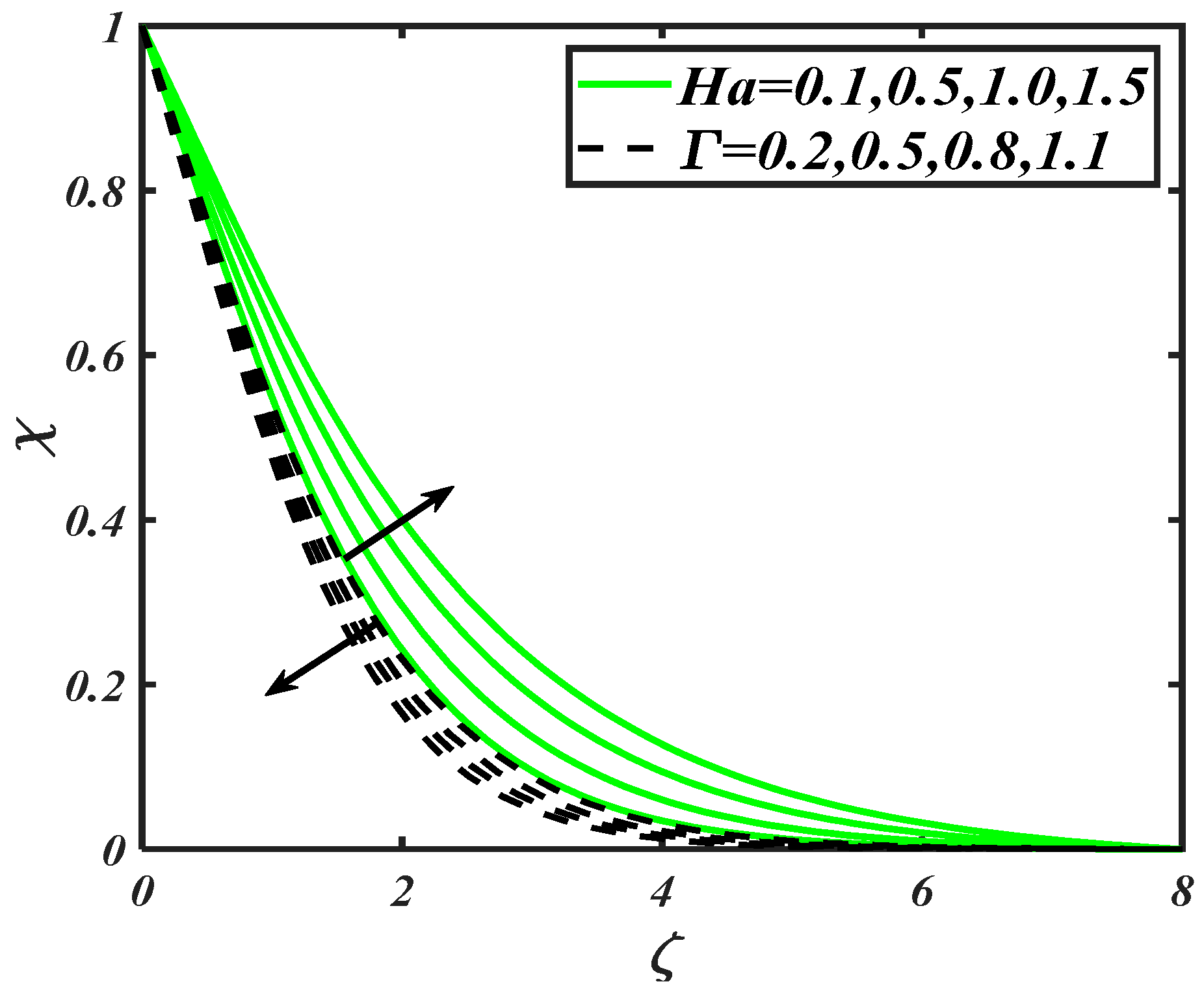
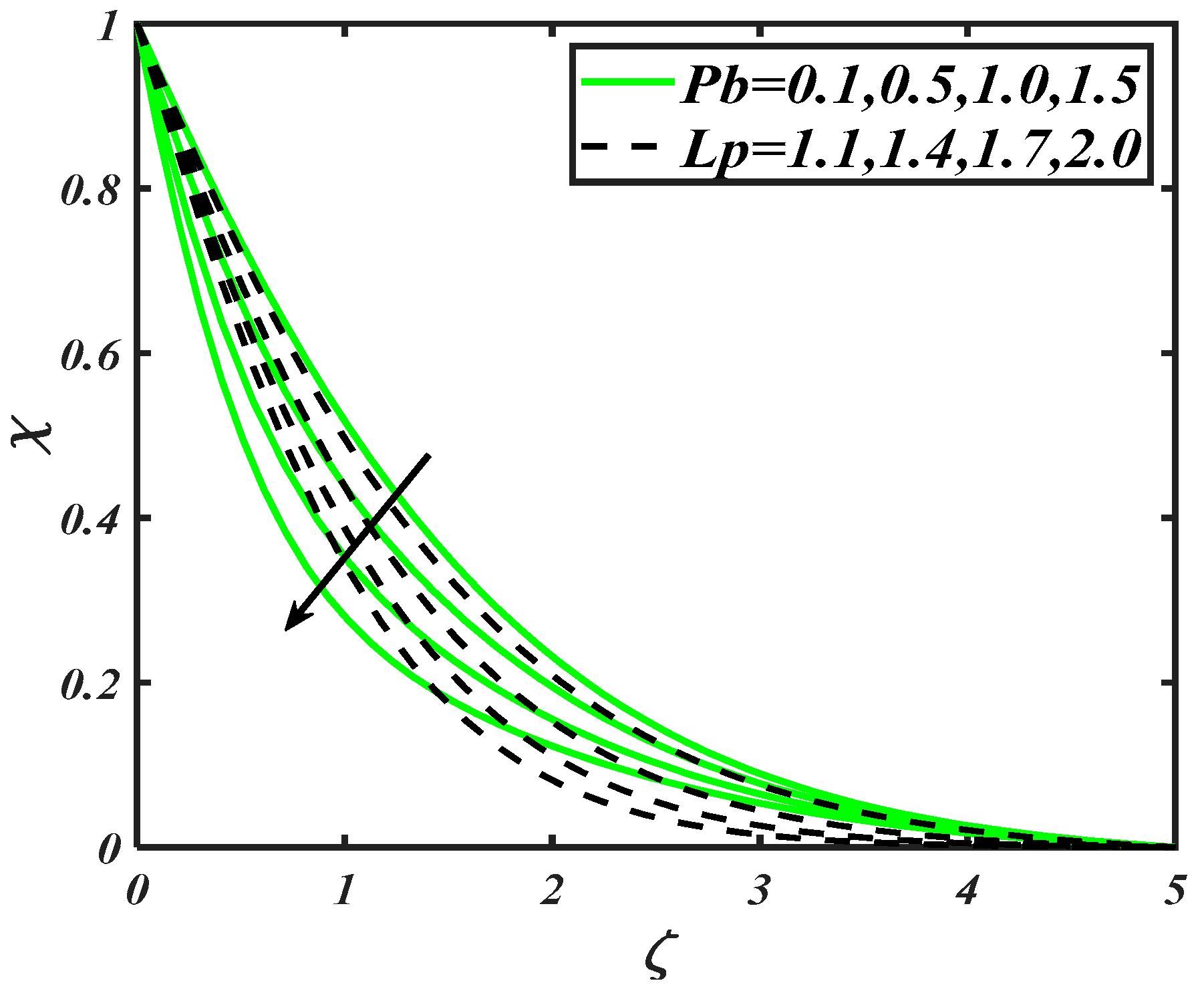
| Wubshet Ibrahim [35] | Ali et al. [36] | Present Results | |
|---|---|---|---|
| 0.0 | 1.0000 | 1.0000 | 1.0000 |
| 1.0 | 1.4142 | 1.41421 | 1.4142 |
| 5.0 | 2.4495 | 2.44948 | 2.4496 |
| 0.1 0.4 0.7 | 0.3 | 1.0 | −1.0 | 0.1 | 0.1 | 0.1 | 0.3648 0.4027 0.4335 |
| 0.1 0.4 0.7 | 0.4297 0.4093 0.3924 | ||||||
| 2.0 3.0 4.0 | 0.2567 0.1959 1.1589 | ||||||
| −2 −3 −4 | 0.2489 0.1872 0.1532 | ||||||
| 0.2 0.5 0.7 | 0.3646 0.3273 0.2941 | ||||||
| 0.2 0.3 0.4 | 0.3784 0.3816 0.3876 | ||||||
| 0.2 0.3 0.4 | 0.3804 0.3864 0.3927 |
| 0.1 0.4 0.7 | 0.1 | 0.1 | 0.1 | 0.7 | 2.0 | 0.8 | 0.3 | 0.2 | 0.4022 0.3775 0.3558 |
| 0.2 0.5 0.8 | 0.3935 0.3933 0.3931 | ||||||||
| 0.2 0.5 0.8 | 0.3923 0.3885 0.3845 | ||||||||
| 0.2 0.5 0.8 | 0.4016 0.4211 0.4364 | ||||||||
| 1.0 3.0 5.0 | 0.2865 0.4637 0.5521 | ||||||||
| 1.0 1.5 1.5 | 0.3306 0.3640 0.3855 | ||||||||
| 0.1 0.5 0.8 | 0.4848 0.4262 0.3754 | ||||||||
| 0.1 0.4 0.7 | 0.4104 0.3852 0.3604 | ||||||||
| 0.1 0.3 0.4 | 0.5521 0.3935 0.3926 |
| 1.0 2.0 3.0 | −1 | 0.1 | 0.5 | 0.2 | 0.2 | 0.7 | 0.5348 0.5004 0.4766 |
| 0.1 | −2.0 −3.0 −4.0 | 0.5307 0.4950 0.4727 | |||||
| 0.2 0.5 0.8 | 0.6024 0.6316 0.6545 | ||||||
| 1.0 2.0 3.0 | 0.6069 0.5995 0.5954 | ||||||
| 0.2 0.3 0.5 | 0.2052 0.7703 1.2613 | ||||||
| 0.4 0.5 0.6 | 1.1806 0.2952 0.1687 | ||||||
| 2.0 3.0 4.0 | 0.4297 0.6956 0.8282 |
| 0.2 0.6 0.8 | 1.02 | 0.2 | 1.0 | −1.0 | 0.1 | 0.1 | 0.1 | 0.1 | 0.6076 0.8312 1.0577 |
| 0.5 1.0 1.5 | 0.6115 0.7172 0.8105 | ||||||||
| 0.1 0.4 0.7 | 0.7759 0.8061 0.8307 | ||||||||
| 2.0 3.0 4.0 | 0.4911 0.4545 0.4297 | ||||||||
| −1.0 −2.0 −3.0 | 0.4866 0.4488 0.4256 | ||||||||
| 0.2 0.5 0.8 | 0.5657 0.5990 0.6257 | ||||||||
| 0.2 0.6 1.0 | 0.8150 0.8330 0.8512 | ||||||||
| 0.2 0.5 0.8 | 0.5521 0.5518 0.5515 | ||||||||
| 0.2 0.5 0.8 | 0.5502 0.5438 0.5371 |
© 2019 by the authors. Licensee MDPI, Basel, Switzerland. This article is an open access article distributed under the terms and conditions of the Creative Commons Attribution (CC BY) license (http://creativecommons.org/licenses/by/4.0/).
Share and Cite
Alwatban, A.M.; Khan, S.U.; Waqas, H.; Tlili, I. Interaction of Wu’s Slip Features in Bioconvection of Eyring Powell Nanoparticles with Activation Energy. Processes 2019, 7, 859. https://doi.org/10.3390/pr7110859
Alwatban AM, Khan SU, Waqas H, Tlili I. Interaction of Wu’s Slip Features in Bioconvection of Eyring Powell Nanoparticles with Activation Energy. Processes. 2019; 7(11):859. https://doi.org/10.3390/pr7110859
Chicago/Turabian StyleAlwatban, Anas M., Sami Ullah Khan, Hassan Waqas, and Iskander Tlili. 2019. "Interaction of Wu’s Slip Features in Bioconvection of Eyring Powell Nanoparticles with Activation Energy" Processes 7, no. 11: 859. https://doi.org/10.3390/pr7110859
APA StyleAlwatban, A. M., Khan, S. U., Waqas, H., & Tlili, I. (2019). Interaction of Wu’s Slip Features in Bioconvection of Eyring Powell Nanoparticles with Activation Energy. Processes, 7(11), 859. https://doi.org/10.3390/pr7110859







